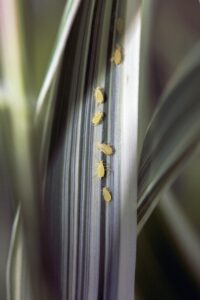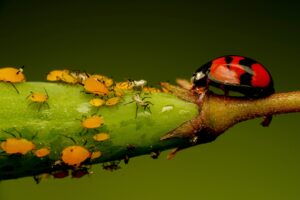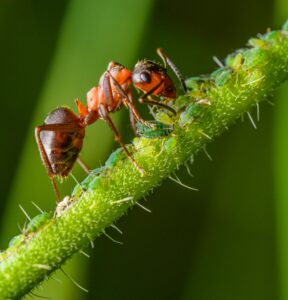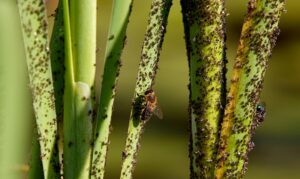In the vibrant world of flowers, where beauty and fragrances captivate our senses, there exists a hidden threat – aphids. These tiny pests, though often overlooked, can wreak havoc on our beloved blooms, causing damage that extends beyond mere aesthetics.
Understanding Aphids
Aphids, scientifically known as Aphidoidea, belong to the order Hemiptera, comprising over 4,000 species. These minuscule insects typically measure between 1 to 10 millimeters in length, making them almost invisible to the naked eye. Despite their small size, aphids are notorious pests in agriculture, causing significant damage to crops worldwide. Measuring just a few millimeters in size, aphids possess specialized mouthparts designed for piercing and sucking sap from plant tissues, making them formidable adversaries for flower enthusiasts.

Lifecycle and Reproduction
One of the most remarkable features of aphids is their reproductive strategy, which combines sexual and asexual reproduction. During favorable conditions, female aphids can reproduce asexually, giving birth to live offspring without the need for mating. This rapid reproductive cycle allows aphid populations to explode under favorable conditions, posing a serious threat to agricultural productivity.
Common Aphid Species Affecting Flowers
Several aphid species are notorious for infesting flower gardens, targeting a wide range of flowering plants. Among the most common offenders are the green peach aphid (Myzus persicae), the rose aphid (Macrosiphum rosae), and the black bean aphid (Aphis fabae). Each species exhibits unique feeding preferences and behaviors, necessitating tailored control strategies for effective management.
Feeding Habits and Damage of Aphids
Aphids are sap-sucking insects, primarily feeding on the phloem sap of plants. Their piercing mouthparts penetrate plant tissues, extracting vital nutrients essential for growth and development. However, this feeding behavior can have detrimental effects on plant health, leading to stunted growth, wilting, and the transmission of plant diseases. Furthermore, aphids excrete a sticky substance known as honeydew, which promotes the growth of sooty mold, further compromising plant vitality. By transmitting plant viruses and promoting the growth of sooty mold through their honeydew excretions, aphids compromise the overall vitality and aesthetic appeal of flower gardens.

How to Control Aphids Attack?
Cultural Practices to Prevent Aphid Infestations
Prevention is often the first line of defense against aphid infestations in flower gardens. Implementing cultural practices that promote plant health and resilience can help deter aphids and minimize their impact. Regular inspection of plants for early signs of infestation, proper spacing to encourage air circulation, and the removal of weeds and debris that harbor aphids are simple yet effective strategies for preventing aphid outbreaks.
Organic Remedies for Aphid Control
For those seeking eco-friendly alternatives to chemical pesticides, organic remedies offer viable solutions for managing aphids in flower gardens. Homemade insecticidal soaps, neem oil sprays, and garlic-pepper spray formulations can effectively deter aphids while minimizing harm to beneficial insects and the environment. Additionally, introducing companion plants with natural repellent properties, such as marigolds and chives, can help repel aphids and attract beneficial insects.
Integrated Pest Management (IPM) Strategies
Integrated pest management (IPM) approaches provide a holistic framework for managing aphids in flower gardens, combining multiple tactics to achieve sustainable pest control outcomes. By integrating cultural practices, biological control agents, and targeted pesticide applications judiciously, gardeners can effectively suppress aphid populations while minimizing environmental impact. Moreover, ongoing monitoring and adaptation of control strategies based on pest dynamics and plant health indicators are essential components of successful IPM programs.
Natural Predators of Aphids
Nature has bestowed flower gardens with a diverse array of allies in the fight against aphids. Ladybugs, lacewings, parasitic wasps, and hoverflies are just a few examples of beneficial insects that prey on aphids, helping to maintain ecological balance and minimize pest populations. Encouraging the presence of these natural predators through habitat diversification and avoiding broad-spectrum insecticides can serve as a sustainable aphid control strategy.

Chemical Solutions for Aphid Control
Chemical pesticides offer a rapid and effective means of controlling aphid populations in flower gardens, providing immediate relief from infestations. Several classes of insecticides are commonly used for aphid control, including pyrethroids, neonicotinoids, and organophosphates. These chemicals target aphids through various modes of action, disrupting their nervous system, feeding behavior, or growth and development processes.
Efficacy of Chemical Insecticides
When applied correctly, chemical insecticides can achieve high levels of efficacy in suppressing aphid populations and preventing further damage to flowers. Pyrethroid-based insecticides, such as bifenthrin and permethrin, exhibit rapid knockdown effects on aphids, making them suitable for use in acute infestations. Neonicotinoids, such as imidacloprid and thiamethoxam, offer systemic protection against aphids, as they are absorbed by plant tissues and ingested by feeding insects. Organophosphate insecticides, while effective, are less commonly used due to their broader spectrum of activity and potential environmental hazards.
Safety Considerations
While chemical insecticides can be potent allies in aphid control, their use requires careful consideration of safety precautions to minimize risks to human health, beneficial insects, and the environment. It’s essential to follow label instructions meticulously, including dosage rates, application methods, and pre-harvest intervals. Additionally, avoid applying insecticides during flowering periods to prevent harm to pollinators and beneficial insects. Furthermore, judicious use of chemical insecticides in combination with cultural practices and alternative control methods can help reduce reliance on synthetic chemicals and mitigate potential negative impacts on non-target organisms.
Best Practices for Application
To maximize the effectiveness of chemical insecticides while minimizing adverse effects, adhere to best practices for application. Choose insecticides specifically labeled for aphid control on flowering plants, ensuring compatibility with the target species and application site. Apply insecticides during periods of low bee activity, preferably in the early morning or late evening, to minimize exposure to pollinators. Use calibrated equipment to achieve uniform coverage of plant surfaces while minimizing drift and runoff. Finally, monitor aphid populations regularly and adjust control strategies as needed to maintain effective pest management.

In the intricate ecosystem of flower gardens, aphids pose a formidable challenge to plant health and aesthetic appeal. However, armed with knowledge of aphid biology, cultural practices, and effective control strategies, flower enthusiasts can mitigate the impact of these tiny pests and cultivate flourishing gardens. By embracing sustainable approaches to aphid management and fostering ecological balance, we can preserve the beauty and biodiversity of our flower-filled landscapes for generations to come.


